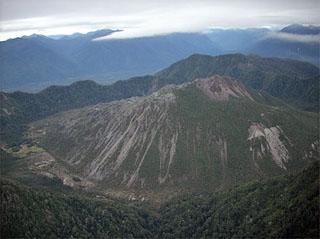Report on Chaiten (Chile) — 9 July-15 July 2008
Smithsonian Institution / US Geological Survey
Weekly Volcanic Activity Report, 9 July-15 July 2008
Managing Editor: Sally Sennert.
Please cite this report as:
Global Volcanism Program, 2008. Report on Chaiten (Chile) (Sennert, S, ed.). Weekly Volcanic Activity Report, 9 July-15 July 2008. Smithsonian Institution and US Geological Survey.
Chaiten
Chile
42.8349°S, 72.6514°W; summit elev. 1122 m
All times are local (unless otherwise noted)
SERNAGEOMIN reports through 12 July 2008 indicated that the eruption at Chaitén was continuing, although poor weather conditions made visual observations difficult. However, explosion plumes were seen on some occasions. Volcano-tectonic (VT) earthquakes continued, concentrated on the E and SE crater rim. Seismicity doubled during 10-12 July, and some VT events were greater than M 2.2.
Ash advisories issued by the Buenos Aires VAAC noted continuous emissions based on webcam observations during 9-11 July, but plumes could not be seen in satellite imagery.
Geological Summary. Chaitén is a small caldera (~3 km in diameter) located 10 km NE of the town of Chaitén on the Gulf of Corcovado. Multiple explosive eruptions throughout the Holocene have been identified. A rhyolitic obsidian lava dome occupies much of the caldera floor. Obsidian cobbles from this dome found in the Blanco River are the source of artifacts from archaeological sites along the Pacific coast as far as 400 km from the volcano to the N and S. The caldera is breached on the SW side by a river that drains to the bay of Chaitén. The first recorded eruption, beginning in 2008, produced major rhyolitic explosive activity and building a new dome and tephra cone on the older rhyolite dome.
Sources: Buenos Aires Volcanic Ash Advisory Center (VAAC), Servicio Nacional de Geología y Minería (SERNAGEOMIN)

